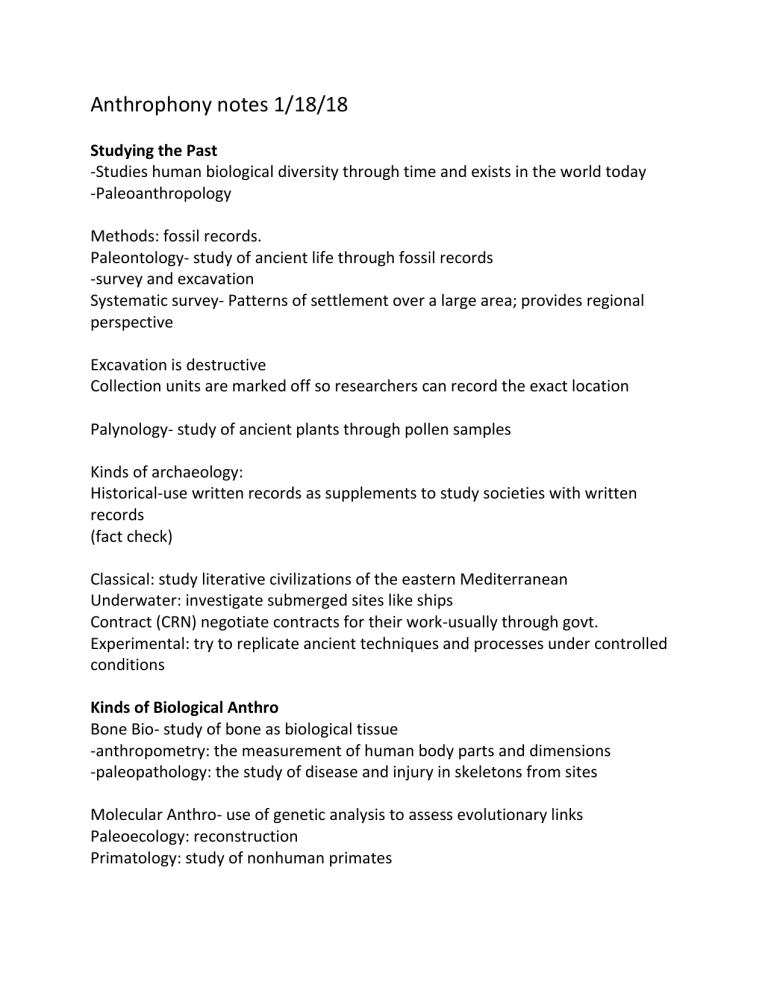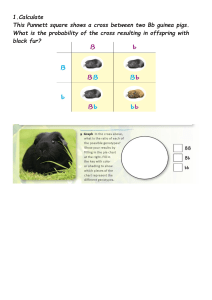Anthrophony Lecture Notes: Paleoanthropology & Natural Selection
advertisement

Anthrophony notes 1/18/18 Studying the Past -Studies human biological diversity through time and exists in the world today -Paleoanthropology Methods: fossil records. Paleontology- study of ancient life through fossil records -survey and excavation Systematic survey- Patterns of settlement over a large area; provides regional perspective Excavation is destructive Collection units are marked off so researchers can record the exact location Palynology- study of ancient plants through pollen samples Kinds of archaeology: Historical-use written records as supplements to study societies with written records (fact check) Classical: study literative civilizations of the eastern Mediterranean Underwater: investigate submerged sites like ships Contract (CRN) negotiate contracts for their work-usually through govt. Experimental: try to replicate ancient techniques and processes under controlled conditions Kinds of Biological Anthro Bone Bio- study of bone as biological tissue -anthropometry: the measurement of human body parts and dimensions -paleopathology: the study of disease and injury in skeletons from sites Molecular Anthro- use of genetic analysis to assess evolutionary links Paleoecology: reconstruction Primatology: study of nonhuman primates Who Owns the past? Kennewick man-specimen discovered “the bones that launched a thousand articles” 1996 in Columbia river (Washington) –found a skull (oldest skull found in US) NAGPRA- for museums and federal agencies to return native American itemshuman remains, sacred objects for cultural reasons Significance- who were the first Americans? How did they arrive? What were their relationships to other cultures? Controversy- Umatilla Tribe claimed ancestry -skeletal morphology unlike modern native Americans -most similar to a group from northern Japan 1/23/18 Darwin- different beak finches Observations: - Individuals in population differ from each other - These differences are heritable- passed from parent to offspring - Population growth outstrips resources Alfred Wallace-On the Origin of Species by Means of natural selection 1. There will always be competition over resources: Most offspring will not survive to reproduce 2. Individuals with features will allow them to outcompete others for limited resources and will have more successful offspring 3. Offspring will look like their parents, and the population will change through time to resemble the individuals best equipped 4. Given enough time, new species will evolve Adaptation- anatomical, physiological, or behavioral response of organisms/populations to the environment Mutation- any error that occurs in the process of copying DNA that can be transmitted to daughter cells The only mutation that are heritable- occurs in meiosis What is the original source of variation- Mutation Natural selection- Changes in frequencies of certain traits in populations between generations due to differences in reproductive success between individuals Human Biological Variation- Natural selection Melanosomes produced in melanocytes Biologically: race isn’t real Culturally: real Lactase-enzyme that breaks down lactose(glucose/galactose) Lactase persistence is caused by a mutation on Chromosome 2 Much of the variation within and between human populations could be considered adaptive -environmental context 1/30/18 Clever Monkeys






